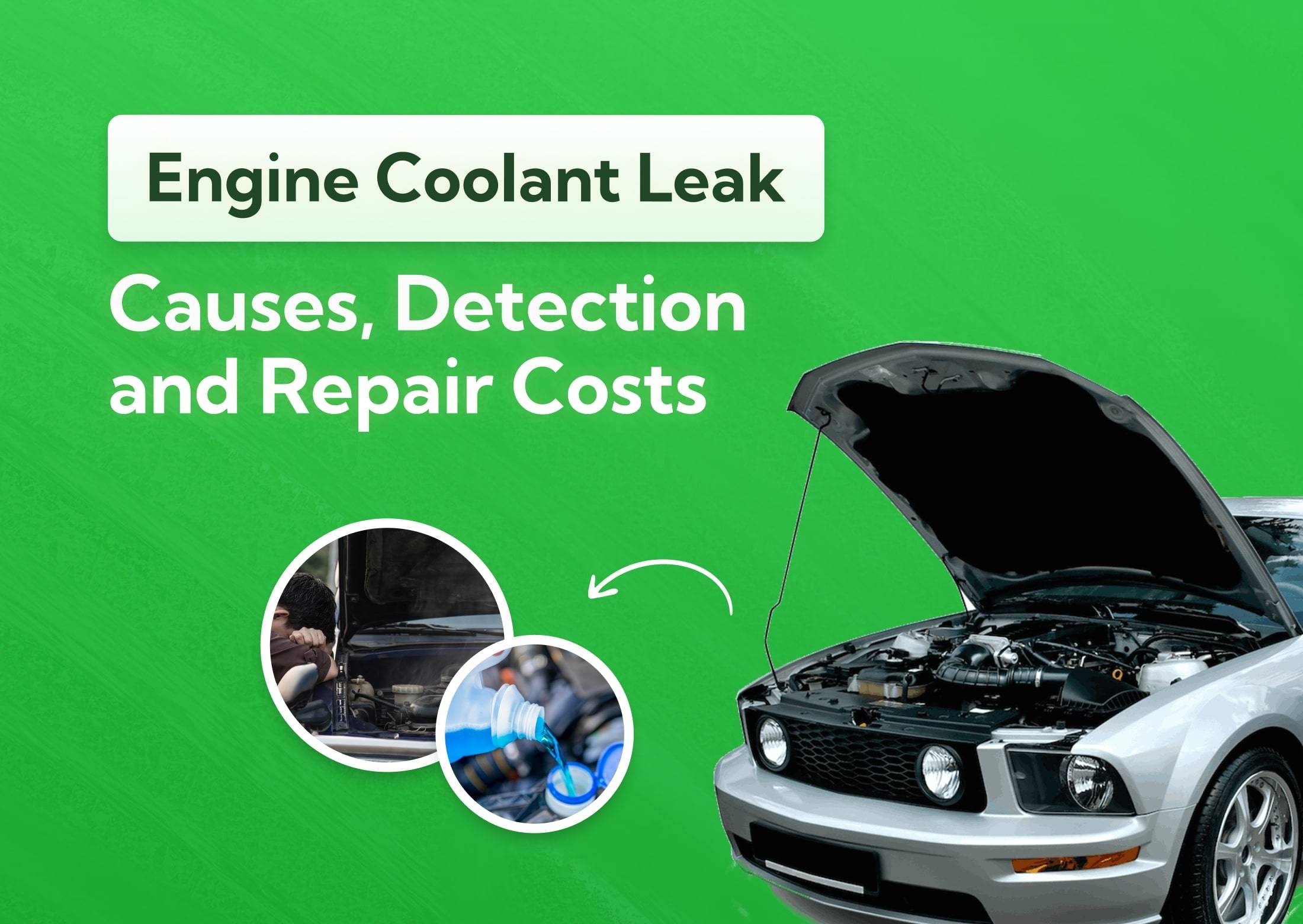Engine Coolant Leak: Causes, Detection and Repair Costs
Coolant leaks might start small, but they can quickly lead to overheating and major engine damage if you ignore them. In this guide, you’ll learn how to spot a coolant leak, what causes it, how much repairs typically cost and when it’s worth fixing versus scrapping your car.
Last updated: 25th November, 2025

Anthony Sharkey is COO at New Reg Limited (Car.co.uk, Trader.co.uk, Garage.co.uk), driving innovation in vehicle recycling, logistics, and customer experience.

Listen to this story
Coolant leaks are among the most common (and worrying) issues drivers face here in the UK. They can stem from something as small as a cracked hose or loose clamp, or something more serious like a damaged radiator, water pump or head gasket.
Whatever the cause, it means your engine isn’t being cooled properly. If you ignore that, it’ll overheat rather quickly, which will lead to major damage.
You’ll usually spot a leak through puddles under your car, a sweet smell from the engine bay or a rising temperature gauge. Some drivers even notice the heater blowing cold air because the coolant level has dropped too low.
Repairs for these kinds of issues range anywhere from about £50 for a simple hose replacement to well over £1,000 if you need to replace the whole system.
In this guide, I’ll walk you through the common symptoms, causes, repair options and what to do if your car’s losing coolant (including when it’s worth fixing and when you might be better off scrapping it).
What's in this article
What is engine coolant?
Engine coolant, sometimes also called antifreeze, is the liquid that keeps your engine from overheating. It circulates through the engine and radiator, absorbing heat and carrying it away so your car maintains a safe operating temperature.
Coolant also prevents freezing in cold weather and helps stop corrosion inside your engine’s cooling system. It’s a blend of water and chemical additives that raise the boiling point and lower the freezing point, keeping the system stable in every season.
Maintaining the right coolant level is just as important as having any at all. Too little? Your engine can overheat or seize. Too much? The system becomes over-pressurised. So routinely checking and topping it up keeps your car running smoothly and protects it from costly damage.
What causes engine coolant leaks?
Coolant leaks can come from several places in your car’s cooling system and not all are easy to spot.
- Over time, rubber hoses and seals naturally wear out and let coolant to drip out slowly.
- Radiators can corrode or develop small cracks.
- A failing water pump can start leaking through its gasket or shaft seal.
- A cracked engine block or blown head gasket will cause coolant to mix with oil (a much more serious issue).
- Even the thermostat housing, which controls coolant flow, develops leaks when its seal fails or the casing cracks.
Head-on damage from a car accident can also result in a coolant leak if the hoses, gaskets or the radiator itself breaks. And as your car gets older and you put more mileage on it, your chances of having a coolant-related issue increase significantly.
Let’s take a closer look at the issues leading up to engine coolant leakage and how you might be able to identify them.
Worn-out hoses and seals
Hoses carry coolant between the engine, radiator and heater core. Seals keep everything watertight where the different parts connect. This is something you’ll usually be able to see. Look for cracks, soft spots and bulges.
These parts generally last 4-10 years. Over time, constant heat, pressure and vibration cause rubber hoses to become brittle and seals to harden or crack. Once that happens, coolant starts seeping or spraying out when the engine is hot and under pressure.
This, like most coolant problems, is predominantly related to maintenance (or lack thereof). If you change your hoses when they’re starting to get worn, you’re generally not going to have this issue.
Radiator problems
Your radiator plays a central role in cooling the engine by releasing heat from the circulating coolant. When it’s damaged, that cooling process starts to fail (and leaks follow shortly behind).
Corrosion is the most common issue. It comes from old or contaminated coolant that’s lost its protective properties. If you don’t change the coolant regularly, rust and mineral buildup eat through the radiator’s thin metal walls.
Cracks can also form from repeated heating and cooling cycles, or from small impacts like road debris. Clogs build up inside over time when coolant isn’t flushed as part of routine maintenance.
Water pump failure
The water pump keeps coolant moving through your engine and radiator. Without it, the coolant can’t circulate and the engine will quickly overheat. Water pumps last 60,000 to 100,000 miles, so if you haven’t changed yours in a while, this could be the issue.
Leaks often happen when the pump’s gasket or internal seals wear out. Then, heat and pressure weaken these components, and coolant escapes from the pump housing. In some cases, the pump’s impeller or bearings fail, creating extra vibration and making the leak worse.
If the issue is water pump failure, you’ll usually notice a small puddle of coolant under the front of the engine or a grinding noise from the pump area. If the leak is caught early, replacing the gasket might be enough. If the pump itself is worn out, you’ll need a full replacement.
Cracked engine block or blown head gasket
These are the most serious types of coolant leaks, and they’re usually hard to miss.
A blown head gasket allows coolant to leak internally into the combustion chamber or oil passages. A cracked engine block is even worse because it can cause coolant to pour out externally or leak internally. Both cause rapid overheating and irreversible engine damage.
Both issues happen when prolonged overheating or freezing temperatures expand and contract the inside your engine metal. Unfortunately, repairs are rarely cheap or simple, which is why when you notice symptoms like white smoke and milky oil, stop driving immediately and have the car towed to a qualified mechanic.
Thermostat housing
The thermostat housing controls how coolant flows between the engine and radiator. It holds the thermostat in place and seals the connection between coolant passages.
Because it’s constantly exposed to heat and pressure, the housing or its gasket can eventually crack or warp. When that happens, coolant leaks around the seal and pools near the top or front of the engine. Plastic housings are especially prone to this because they get brittle with age.
Replacing the gasket or the entire housing is usually straightforward and relatively inexpensive, which is why you should always have it inspected during maintenance. Otherwise, ignoring a leak will lead to overheating or low coolant levels that cause much bigger issues down the line.
What are the signs of a coolant leak?
You’ll usually know something’s wrong if you spot a bright-coloured puddle under your car (most coolants are green, pink or orange). A sweet, syrup-like smell coming from the engine bay is another dead giveaway.
If the leak’s getting worse, the engine will start to overheat, coolant levels will drop and you might see white exhaust smoke if it’s actively burning inside the engine. Modern cars will also alert you with a dashboard warning light or low coolant message when this happens.
Puddle under the vehicle
This is normally the first visible clue of a coolant leak. Coolant is either bright green, pink, orange or blue depending on the type and it has a slick texture with a slightly sweet smell. It’s not to be confused with water condensation from the air conditioning system, which is clear and odourless.
If the puddle forms near the very front of the car, it’s likely coming from the radiator, a hose, or the water pump. A leak closer to the middle or rear of the engine bay points to the heater core or head gasket. And if it looks like water, it’s overly diluted.
In either case, even a small patch of coolant means the system isn’t sealed properly.
Sweet smell
That sweet, sugary scent you sometimes notice around your car is one of the most recognisable signs of a coolant leak. Engine coolant contains ethylene glycol, which gives off a distinctive sweet odour when it evaporates.
You’ll smell it inside the cabin if the heater core is leaking, or from the engine bay if a hose, radiator or gasket is failing. Even if you can’t see an obvious puddle, that smell means coolant is escaping somewhere and it’s only a matter of time before overheating follows.
If you notice the sweet smell, get the car checked out ASAP.
Overheating engine
If coolant has been leaking for long enough, your engine’s running at higher-than-normal temperatures. Fluid isn’t circulating through the system, so heat can’t escape properly and the temperature gauge will climb into the red.
If engine overheating is the actual issue, you’ll notice steam coming from under the bonnet or the heater suddenly blowing cold air, both of which are signs the coolant levels have dropped too low.
Pull over and switch the car off immediately if this happens. Driving while it’s hot can warp the cylinder head or blow the head gasket.
Low coolant levels
If it’s been 30,000 to 60,000 miles since your last coolant change and it’s already very low, that’s a strong sign there’s a leak somewhere in the system. The coolant reservoir should hold a steady level between the ‘MIN’ and ‘MAX’ marks. A noticeable drop early on (say, less than 20,000 miles) means the system isn’t sealed properly.
Sometimes the leak is small and only shows as a gradual loss over days or weeks. In other cases, you might see a rapid drop, especially after a drive.
If you’re going to check the coolant levels, always do so when the engine is cold. That means wait 15 to 30 minutes before opening the bonnet if you’ve just pulled over and stopped the car. Otherwise, boiling coolant and the steam it produces could potentially burn you.
White exhaust smoke
Thick white smoke coming from the exhaust pipe is a classic sign that coolant is leaking into the engine’s combustion chambers. If you’re here, the problem is already severe. It usually means you’ve blown the head gasket, cracked the cylinder head, or damaged engine block.
You might also notice the exhaust smells slightly sweet, or that it lingers longer than normal. If this happens consistently (and not just on a cold start), it’s a serious issue that needs immediate attention.
Continuing to drive will eventually lead to engine seizure and contamination of the oil system, both of which are extremely expensive to repair.
Dashboard warning lights
Modern cars are quick to alert you when coolant levels or temperatures aren’t right. You might see a red or amber temperature symbol, a low coolant message or a general engine warning light.
These tell you the system has detected overheating or a drop in coolant pressure. Don’t ignore them. Pull over safely, switch off the engine, let it cool, then check the coolant reservoir.
Driving with a warning light like this might cause serious damage if the leak is large or the system has lost too much pressure to circulate coolant properly.
How to fix a coolant leak
How you fix a coolant leak depends on where it’s coming from and how severe it is. Small leaks from hoses, clamps or seals can often be repaired cheaply by replacing the damaged part or tightening the connection. If the radiator is corroded or cracked, a replacement is the better long-term fix.
Leaks from the water pump, thermostat housing and heater core require more labour and parts, but they’re still repairable. And if the problem involves a blown head gasket or cracked engine block, you’re looking at a major repair that might cost more than the car’s value.
Identifying the source of the leak
Your first step when you notice a coolant leak is to find the source. That’s how you’ll know where to go from there.
A quick step-by-step:
- Park on level ground, let the engine cool completely, and switch off the ignition.
- Check the coolant reservoir level against the MIN and MAX marks. Note any sudden drop.
- Look for fresh drips and dried crusty residue around hose joints, the radiator end tanks, the thermostat housing and the water pump.
- Place clean cardboard under the engine bay. Fresh drops will help you trace the drip line back to its source.
- Inspect under the car with a torch to examine all hoses, clamps, radiator seams, the water pump weep hole, thermostat housing, heater hoses at the bulkhead and the expansion tank cap.
- Individually examine each of those components for wet areas, white or coloured deposits and hairline cracks.
- Run the engine until it’s warm while watching the temperature gauge. Look for seepage as pressure builds. Switch off if the gauge climbs quickly.
- Squeeze the top radiator hose gently. A soft or collapsed hose indicates internal failure.
- Smell for a sweet scent inside the cabin. Fogged windows with a sweet smell point to a heater core leak.
If you still can’t find it, a mechanic can attach a hand pump to the expansion tank to pressurise the system with the engine off. Holding pressure will reveal leaks as beads of coolant at the fault point.
For extra stubborn cases, they’ll add a UV coolant dye to the system, run the engine briefly, then scan with a UV torch. The dye fluoresces at the leak path, making the exact location obvious.
Replacing a faulty radiator or water pump
If the leak comes from the radiator or water pump, your mechanic will almost definitely recommend a replacement. Both parts are essential for circulating coolant and keeping the engine at the right temperature, but once they start leaking, repair is difficult if not impossible.
- Radiator replacement (3 to 6 hours): The mechanic will start by draining the old coolant and removing the hoses, fan shroud and mounting brackets that hold the radiator in place. Once the old unit is out, they’ll install a new radiator, refit the hoses and fill the system with fresh coolant. The system is then bled to remove trapped air and tested to make sure pressure and temperature hold steady with no new leaks.
- Water pump replacement (3 to 6 hours): If they have to, the mechanic will remove components that are in the way, unbolt the old pump and clean the surfaces before fitting a new one with a fresh gasket or seal. Once it’s reassembled, they’ll refill, pressure-test and monitor the system for leaks and unusual noises as the engine warms up.
Both jobs are a lot more involved. The mechanic might have to remove the majority of your car’s front end to get access, and the water pump is buried behind the engine’s belts or timing covers. Expect to spend a bit more because of the labour.
Sealing leaks in hoses and clamps
If a hose or clamp only has a small leak and you can’t make it to the mechanic right away, you can try coolant system sealant or hose repair tape.
This is only ever a short-term solution, though. Once a hose has split or softened, replacement is the only proper solution.
To fix it correctly, the mechanic will:
- First drain the coolant to prevent spills.
- Then remove the damaged hose, clean the fittings and check the metal or plastic connections for corrosion.
- Fit and secure a new hose fresh clamps to ensure a tight, leak-free seal.
- Refill the system and pressure-test it to confirm the repair.
It’s a relatively inexpensive job, especially compared to the risk of overheating, more coolant loss and potentially irreversible damage. And assuming you buy high-quality replacement parts, your new hose will last years if you keep up with regular maintenance.
Replacing the head gasket
Once the gasket fails, the engine can no longer seal the combustion chambers properly. That allows coolant, oil and exhaust gases to mix. You’ll usually only face this if a coolant leak has already led to overheating and coolant mixing with engine oil.
The basic steps a mechanic will follow:
- Drain all coolant and engine oil.
- Remove the intake, exhaust, and other components blocking access to the cylinder head.
- Unbolt and lift the cylinder head carefully from the engine block.
- Inspect both surfaces for warping or cracks and send the head for machining if needed.
- Fit a new head gasket and reinstall the head, tightening bolts in the correct sequence and to precise torque settings.
- Refit all components, refill fluids, and bleed the cooling system.
- Start the engine and perform compression and leak tests to ensure a perfect seal.
Head gasket replacement is one of the most expensive cooling system repairs. And only a qualified mechanic should handle this job; it’s incredibly complicated and requires a high degree of precision.
Thermostat housing replacement and sealing
Leaks around the thermostat housing are fairly common. What usually causes them is a cracked casing or worn gasket. Because it controls how coolant circulates between the engine and radiator, even a small thermostat leak leads to overheating.
To fix it, the mechanic will:
- Drain the coolant to prevent spills and relieve pressure in the system.
- Disconnect the hoses linked to the thermostat housing.
- Remove the housing and clean the mating surfaces thoroughly.
- Inspect the thermostat inside for corrosion and sticking.
- Replace the housing entirely if it’s cracked.
- Apply a new gasket before refitting.
- Refill, bleed and pressure-test the cooling system to confirm a proper seal.
During the process, the thermostat itself is also checked to make sure it’s opening and closing correctly. If it’s faulty, they’ll replace it to keep your engine running at the right temperature and ensure consistent performance after the repair.
How much does it cost to repair a coolant leak?
The cost of fixing a coolant leak in the UK varies massively depending on what’s gone wrong.
Simple repairs like tightening or replacing a hose or clamp cost between £50 and £200 including parts and labour. If the radiator, thermostat housing or water pump is leaking, expect a bill anywhere from £250 to £700. And more severe problems like a blown head gasket or cracked engine block climb well beyond £1,000, sometimes reaching £2,000 or more.
The key is catching the issue early. A small leak repaired quickly can save you from a far more expensive repair later.
Average costs for coolant leak repairs
On average, repairing a coolant leak in the UK typically falls between £100 and £900, though it can exceed £1,500 for severe engine-related issues.
Besides the type of work you need done, the exact cost depends heavily on your car’s make and model. Compact cars are cheaper to work on because parts are easier to access and replace. Premium and performance cars require specialised components and more labour time.
Coolant leak repair costs (UK, 2025)
| Repair type | Typical parts and labour range | Notes on severity and what drives cost |
|---|---|---|
| Minor leak: hose / clamp / seal | £50 to £200 | Simple hose or clamp replacement, low labour. |
| Mid-level: radiator repair/replacement | £150 to £900 | Radiator removed/replaced, more labour + parts. |
| Mid-level: water pump repair | £250 to £700 | Labour-intensive, pump + seal(s), depending on access. |
| Major: head gasket replacement / engine work | £500 to £2,000+ | Extensive teardown, high labour, possible additional parts. |
Cost breakdown for radiator, water pump and hoses
For most coolant-related repairs, the parts themselves are surprisingly affordable. What really drives the price up is labour. Many of these components are buried deep within the engine bay, meaning hours of disassembly and reassembly.
And labour rates vary across the UK. Independent garages outside major cities typically charge £60 to £80 per hour, while garages in the South East or London easily reach £90 to £120. Because of that, the same job might cost hundreds more depending on where you’re based.
Radiator, water pump and hose repair costs (UK, 2025)
| Repair type | Typical cost range (parts + labour) | Notes |
|---|---|---|
| Radiator replacement | £150 to £900 | Range covers standard up to more complex installs. |
| Water pump replacement | £115 to £375 | Easier access models toward lower end. |
| Hose / clamp / minor leak fix | £50 to £200 | Lowest-cost category when leak is minor. |
Factors affecting coolant leak repair costs
Several factors influence how much you’ll pay to fix a coolant leak:
- Location of the leak: Minor leaks (like hoses) are cheaper to fix than internal engine faults.
- Vehicle make and model: Premium and performance cars use more expensive parts and take longer to work on.
- Labour time: Complex repairs that require disassembling parts of the engine drive up the total bill.
- Parts quality: OEM components cost more than aftermarket equivalents but last longer and are generally a safer bet.
- Garage location: Labour rates are higher in London and the South East than in small towns.
Repairs carried out at main dealerships also tend to cost a lot more than at independent garages, mainly due to higher labour rates and brand-specific service charges.
DIY vs. professional coolant leak repair costs
If you’re handy with tools, a DIY coolant leak fix will save you big time. Replacing a hose or clamp yourself might cost £20 to £60 in parts compared to £100 to £200 at a garage. Even a radiator swap could drop from £500+ professionally to around £150 to £250 if you source the parts and handle the labour.
Here are my quick cost-saving tips for safe DIY repairs:
- Always diagnose accurately before replacing parts; guessing means wasted money.
- Buy quality parts from reputable suppliers; cheap rubber hoses often fail early.
- Flush and refill coolant properly using the right antifreeze mix.
- Use a torque wrench to tighten clamps and bolts to manufacturer specs.
- Keep records of what you replaced (helpful for resale and future maintenance).
That said, it’s not always worth the risk. DIY repairs are only practical for small, external leaks like hoses, clamps and radiator seams. Anything involving the water pump, thermostat housing or especially the head gasket is a mechanic’s job. Those require specialist tools, torque specs and bleeding procedures that, if done incorrectly, might destroy your engine.
Is it worth fixing a coolant leak?
In most cases, yes. Fixing a coolant leak is absolutely worth it.
The cooling system protects your engine from overheating and even a small leak will quickly lead to serious damage if ignored. Spending a few hundred pounds now will save you thousands later by preventing a blown head gasket or seized engine.
That said, it depends on the car’s age and value. If your vehicle is older and the repair cost is close to or higher than its market value, it might make more sense to scrap it instead.
What the experts say

Steven Jackson OBE
When is fixing a coolant leak worth it?
Fixing a coolant leak is worth it when the car still has solid overall value and the repair cost doesn’t outweigh that.
It’s especially worth repairing if:
- The leak hasn’t yet caused overheating or engine performance issues.
- The repair costs less than roughly 50% of the car’s market value.
- The rest of the vehicle is in good condition and regularly serviced.
- You plan to keep the car for the foreseeable future.
When should you scrap your car due to a coolant leak?
You should scrap your car instead if the coolant leak is severe enough that repairing it costs more than 50% of the car’s value or if it’s likely to lead to ongoing reliability issues.
It’s also worth scrapping if:
- The car frequently overheats even after minor repairs.
- Multiple parts in the cooling system (like the radiator and water pump) are failing at once.
- You’ve already spent money on related engine repairs and problems keep returning.
- The car has rust, high mileage or upcoming expensive fixes that add to the total cost.
How to prevent coolant leaks
Most of the time, a coolant leak is something that’s totally preventable. Most of the time when I see cars that aren’t 15+ years old with coolant leaks, it’s because the owner was neglectful. Now, let’s take a look at how you can prevent this from happening in the first place.
Regular cooling system inspections
Have your mechanic check hoses, seals and the radiator during routine servicing (a good one will do this anyway). This should happen at least annually. Spotting small cracks or corrosion early will stop leaks before they start.
Using the correct coolant mixture
Always use the coolant type and mix ratio recommended by your car’s manufacturer. The right blend of antifreeze and distilled water prevents corrosion, overheating and freezing, all of which will damage your engine components.
Timely repairs of worn parts
Replace ageing hoses, clamps and seals as soon as they show wear. A small leak or soft hose today can turn into a major failure tomorrow. If you follow the two pieces of advice above, they should last somewhere between 4 and 10 years.
Protecting the cooling system from extreme temperatures
Coolant liquid has inhibitors and antifreeze that help it regulate your car’s temperature. So avoid driving with low coolant in very hot or freezing conditions. Extreme heat and cold both strain the system and cause its metal and rubber components to expand, contract or crack faster.
Ensuring proper installation of cooling system parts
When replacing components like the radiator, water pump, or thermostat housing, make sure parts are fitted correctly with new seals and tightened to the right torque. Poor installation is one of the most common causes of repeat leaks.
Frequently asked questions
Technically, you can. But you really shouldn’t. Even a small leak might cause coolant levels to drop quickly, which would cause the engine to overheat. If you suspect a leak, top up the coolant if it’s safe to do so and drive only short distances to a garage for inspection.
Not long at all. Once coolant starts leaking, it’s only a matter of time before the system can’t regulate engine temperature. Depending on the size of the leak and what’s causing it, you could overheat within minutes. If you absolutely have to drive, drive gently, keep a close eye on the temperature gauge and pull over immediately if it rises.
Coolant leaks most often come from worn hoses, loose clamps, the radiator or the water pump. You might also find leaks around the thermostat housing or the heater core. In severe cases, internal leaks from a head gasket or cracked engine block let coolant mix with your engine oil.
A small coolant leak can and very often does lead to major engine damage, which is why you should never ignore it. A slow leak might not seem urgent, but if low coolant levels cause the engine to overheat, it can warp the cylinder head or blow the head gasket rather quickly. Fixing the leak early is always far cheaper than repairing engine damage later.
About Car.co.uk

Share on
Latest news & blogs










